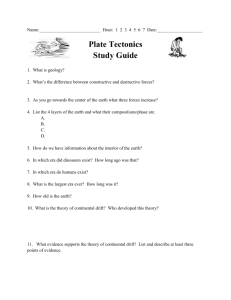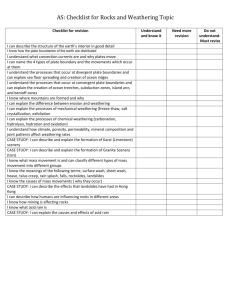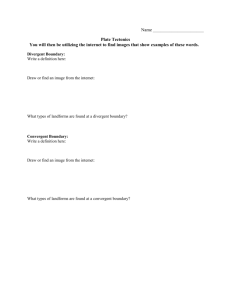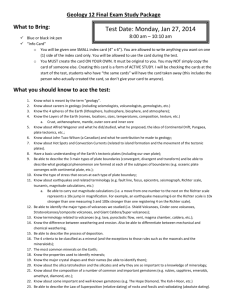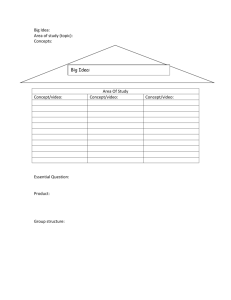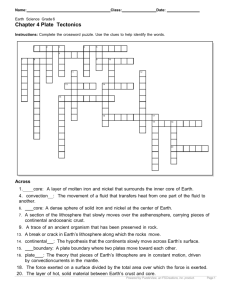AS1.13 Geology scheme 2013
advertisement
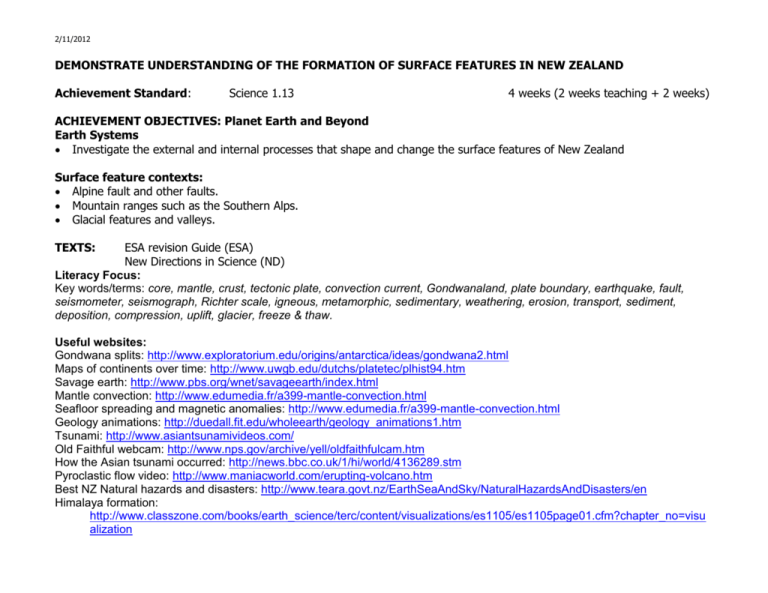
2/11/2012 DEMONSTRATE UNDERSTANDING OF THE FORMATION OF SURFACE FEATURES IN NEW ZEALAND Achievement Standard: Science 1.13 4 weeks (2 weeks teaching + 2 weeks) ACHIEVEMENT OBJECTIVES: Planet Earth and Beyond Earth Systems Investigate the external and internal processes that shape and change the surface features of New Zealand Surface feature contexts: Alpine fault and other faults. Mountain ranges such as the Southern Alps. Glacial features and valleys. TEXTS: ESA revision Guide (ESA) New Directions in Science (ND) Literacy Focus: Key words/terms: core, mantle, crust, tectonic plate, convection current, Gondwanaland, plate boundary, earthquake, fault, seismometer, seismograph, Richter scale, igneous, metamorphic, sedimentary, weathering, erosion, transport, sediment, deposition, compression, uplift, glacier, freeze & thaw. Useful websites: Gondwana splits: http://www.exploratorium.edu/origins/antarctica/ideas/gondwana2.html Maps of continents over time: http://www.uwgb.edu/dutchs/platetec/plhist94.htm Savage earth: http://www.pbs.org/wnet/savageearth/index.html Mantle convection: http://www.edumedia.fr/a399-mantle-convection.html Seafloor spreading and magnetic anomalies: http://www.edumedia.fr/a399-mantle-convection.html Geology animations: http://duedall.fit.edu/wholeearth/geology_animations1.htm Tsunami: http://www.asiantsunamivideos.com/ Old Faithful webcam: http://www.nps.gov/archive/yell/oldfaithfulcam.htm How the Asian tsunami occurred: http://news.bbc.co.uk/1/hi/world/4136289.stm Pyroclastic flow video: http://www.maniacworld.com/erupting-volcano.htm Best NZ Natural hazards and disasters: http://www.teara.govt.nz/EarthSeaAndSky/NaturalHazardsAndDisasters/en Himalaya formation: http://www.classzone.com/books/earth_science/terc/content/visualizations/es1105/es1105page01.cfm?chapter_no=visu alization 2/11/2012 On line mineral key: http://geology.about.com/gi/dynamic/offsite.htm?zi=1/XJ/Ya&sdn=geology&zu=http%3A%2F%2Fwww.minsocam.org%2FMSA %2FK12%2Fproperties%2Fminid%2Fmineralid.html Volcanoes: http://www.volcano.si.edu/ Learning Experiences and content Resources and references 1. Structure of planet Earth and plate tectonics. Brainbops animation: Earth structure. Graphing exercise handout "Depth vs Temp" Revise the following: Earth’s core: Cross-section of Earth (core, mantle, http://videos.howstuffworks.com/science-channel/29142-100-greatestcrust). discoveries-the-core-of-the-earth-video.htm Convection currents in mantle causing Mantle convection: http://www.edumedia.fr/a399-mantle-convection.html movement of plates. Gondwana splits: Continental drift. http://www.exploratorium.edu/origins/antarctica/ideas/gondwana2.html Maps of continents over time: http://www.uwgb.edu/dutchs/platetec/plhist94.htm 2. N.Z on a plate boundary Focus on South Island. Label on map of N.Z. features associated with being on a plate boundary, including: Volcanoes: Taranaki, Ruapehu, Ngaruhoe, Tongariro, L.Taupo, Tarawera, White Is Mountain ranges: Raukumara, Ruahine, Tararua ranges, Kaikoura ranges, Southern Alps. Geothermal: Hanmer Springs, Rotorua. Earthquakes: Napier (1931), Murchison (1930?), Edgecombe (198?), Dusky Sound (2009), Darfield (2010) When reviewing, look at Landsat poster and identify the plate boundary and relate various features to their proximity to plate boundary. Landsat poster of N.Z on wall in R10 Atlases Map of N.Z to cut & paste. 2/11/2012 Learning Experiences and content 3. Types of plate boundary Convergent, divergent and transformational (lateral movement). 4. Mountain building Identify the alpine fault. Describe how the Southern Alps and other mountains in the area have been formed. Uplift and folding. Uplift and tilting. 5. Weathering and ice Mechanical(physical) & chemical weathering Practical: Freeze & Thaw. Heat marble in Bunsen then cool in ice cold water. Repeat. Should begin to crack, Practical: Put plastic drink bottle in a freezer without cap on to observe expansion of water when frozen. 6. Weathering literacy Show video clips on weathering and erosion. Students silently read the text in Nature of Science 2 on mechanical and chemical weathering. Split class in pairs, write one of the Resources and references Gondwanaland cut and paste in folder. Animations: Convergent and divergent boundaries: http://videos.howstuffworks.com/hsw/12652-our-restless-planet-convergentand-divergent-plates-video.htm Seafloor spreading and magnetic anomalies: http://www.edumedia.fr/a399mantle-convection.html Geology animations: http://duedall.fit.edu/wholeearth/geology_animations1.htm And: http://www.classzone.com/books/earth_science/terc/content/visualizations/es1 105/es1105page01.cfm?chapter_no=visualization Brianpops ‘Mountain types’ Marbles, “Heating and Cooling” instruction sheet. Plastic bottles Weathering: http://videos.howstuffworks.com/hsw/21683-weathering-video.htm A4 paper, scissors, coloured pens Nature of Science 2 textbook p196-7 2/11/2012 Learning Experiences and content sentences beside bullet points in coloured pen, cut up sentence into individual words. Pairs rotate around room reassembling sentences. Write sentence in exercise book. 7. Glaciation Show DVD. How glaciers form. Results of glaciation e.g. U-shaped valleys, hanging valleys, moraine, roche moutonee etc 8. Mountains and weather Discuss orographic rainfall & draw diagram of how mountains cause rain on windward side and föhn wind on leeward side. 9. Quiz 10. Assessment task (1 week) Internal assessment AS1.13 Brainstorm surface features that make the Wanaka area distinctive e.g lake, mountains, U-shaped valleys, moraine, hanging valleys, v-shaped valleys, scree, slopes, schist features, wet west, dry east. Resources and references DVD214 Earth – The power of the planet Episode 3 ‘Ice’ ‘Norwester’ video ?. K:\2010 Science\Yr 11 Science\Earth Science\Newlands geology tasks Computers
